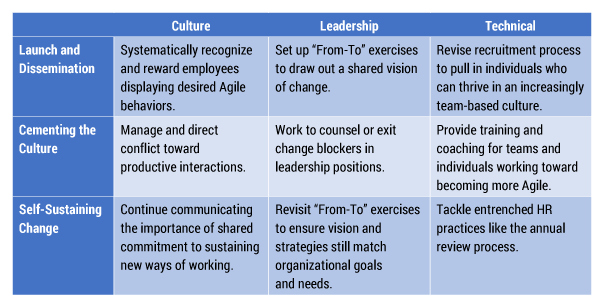BA & SEE EXECUTIVE UPDATE VOL. 20, NO. 15

Organizational agility is a lifelong commitment. It begins with shared understanding, flourishes with mutual accountability, and perseveres with continual reaffirmation. And there is no finish line. This need for constant renewal calls into question the very idea of “Agile transformation,” a term that suggests a one-time organizational metamorphosis rather than a process of ongoing evaluation, assessment, and change. The idea of continuous improvement is indeed continuous — we can always be better.
Ideally, it is the role of everyone in the organization to think about creating and managing that change. In practice, however, many will not have the time, knowledge, or perspective to consider pieces outside their daily routines. Thus, it will fall to a smaller group to think about not just the work, but the ways of working. And nobody in the organization is better suited to take on this task than human resources (HR).
HR practitioners have not always been the first group that comes to mind when discussing the preeminence of people over practice or the idea of self-organizing teams, but times are changing. Organizations large and small, from Google to the US Olympic Committee, are helping evangelize not just new titles for HR leaders but new ways of working. HR, traditionally seen as “candidate screening and legal compliance,” is becoming the go-to department of people — which includes defining and executing the organizational mission and guiding people along the journey of change.
As companies evolve through the stages of increasing agility, the work of HR changes as well. At each stage, there are new priorities and new hurdles that should be both expected and managed (see Table 1).

Launch and Dissemination
A well-formed plan to move toward company-wide agility should begin with an analysis of the current state of the organization. This involves asking the following three key questions:
-
How do we want to work in the future?
-
What must we change to get there?
-
How will we make those changes?
Companies that execute this phase well communicate a clear vision and create broad buy-in by involving people from across the organization. One tactical move HR practitioners can take to help guide these conversations is to work with business leaders on a “From-To” exercise.
This activity involves having participants list the current state of the organization (the “From” column). This requires individuals to acknowledge where they are now — behaviors, culture, key metrics/outcomes that aren’t where you want them to be. In the “To” column, list the behaviors or outcomes that you want. This isn’t necessarily a 1:1 ratio, but could be, especially for key metrics such as sales. The “From-To” exercise can be done on an individual basis, then again later in small groups with readouts to the entire organization. The HR leader can facilitate conversations to agree on the most important outcomes — the final draft of the “To” column — as well as resulting conversations. What is the gap between where we are now and where we want to go? What actions might we take to address these gaps?
The “From-To” exercise can happen at the senior leadership level with the organization considered as a whole but should also be replicated at the level of each individual team. In this way, all employees can weigh in and cocreate the vision of where they want the organization and their teams to be.
Any large organizational shift will initially be met with mixed reaction. Many people will meet these changes with excitement, especially if they are able to see the big picture, while others will be naysayers. During this phase, it is especially important to provide support and reinforcement for positive behaviors that align with and demonstrate an Agile culture. These behaviors include focusing on the customer, delivering value frequently, working collaboratively across multiple functions, relying on face-to-face communication, and challenging the status quo courageously and respectfully. To accelerate the pace of cultural change, HR practitioners must create opportunities — both systematic and informal — to recognize and reward employees that display these behaviors.
Positive storytelling is a powerful way to help the organization on its Agile journey. Public recognition via storytelling helps demonstrate a model for the desired behavior and provides a source of inspiration and encouragement. All-hands, team, or department meetings, town halls, and newsletters all provide opportunities to share success stories featuring outcomes and intermediate behaviors. As the organization maps its destination, this is also a time in which HR must examine and evolve its own ways of working. Your credibility to guide and partner with the organization as a whole will be limited by your own willingness to change.
The recruitment process may be a great place to start. Change in this space can commence at the very beginning, with the job posting. Rather than listing out individual job activities, the posting should focus more on what the team contributes to the organization’s vision and how the new employee will directly tie to the team’s outcomes.
Candidate interviews should reflect the same priorities. Interview questions should spark conversation about working cooperatively with a diverse group of people, as well as times in which the candidate dealt with team conflict. Especially in later phases, having individuals with these skills is absolutely essential.
Cementing the Culture
As the Agile journey continues, it may appear that everyone is on the same page and the new mindset has fully taken hold. However, this moment of perceived peace may be brief. With the honeymoon phase over, patience can wear thin and individuals can lose sight of the “why” behind their efforts — and regress to old habits.
It is normal for teams to experience greater conflict during this time period. Teams must deal with this before it becomes an impediment to future growth, or even motivation to abandon this new way of working. Conflict doesn’t have to be a negative. In fact, high-performing teams can make conflict productive. A core Agile practice that helps teams become comfortable with conflict is the retrospective. My colleagues and I found that teams who commit to regular retrospectives move faster and further toward a culture of trust, transparency, and respect — and they also become more innovative as they learn to hold healthy, worthwhile conflict.
At this phase, it’s important to further focus on behaviors as well as outcomes. While working at a large hosting company, we were 12 months into our own Agile journey when we realized that many teams had hit a plateau. In large part, this was because we were not yet building an overall team culture that would fuel continued success. For example, we still had teams that were reluctant to hold retrospectives and who had outright said there was no way they would admit failures and mistakes in front of their team managers.
HR practitioners must reiterate time and again the desired outcomes individuals are working toward during this period of growth and the behaviors that will get them there. Phase two is also a perfect time to remind people — including yourself — that becoming more Agile is a journey, not a destination. You can’t check “communicate vision” off your to-do list and then never look back. At all times, every organizational decision must be scrutinized for how it aligns with, and furthers, the vision that has been laid out. Even with all that communication, it is still likely that some people will begin working to undermine change. These “blockers” can be found anywhere in an organization but are particularly problematic when they are found within more senior levels of management.
Agile organizations empower team members, not elite figureheads, to make decisions. It’s up to the team to determine the best course of action, and this requires team members to develop the skills needed to problem solve and make decisions together. At the same time, teams that think they need consensus or compromise to move forward will still struggle and stall. Instead, individuals must work past their own biases, respect others’ opinions, ensure everyone is heard, and then decide on how to arrive at the best solution. Furthermore, if caught early, it’s possible to confront negative behaviors and put them to rest by using positive storytelling techniques and reminding people of the “To” state they cocreated, while continuing to make strides toward it.
Finally, some team members may want to change but lack the skills required to thrive in this new way of working. Training and ongoing coaching on emotional intelligence skills such as empathy and active listening can be supplemented with tactical training on good meeting etiquette and running effective retrospectives. These abilities will equip and prepare teams to make continued progress on their path to becoming Agile.
Self-Sustaining Change
A commitment to organizational agility can be exciting in its early stages. But by the point of maturity, everyone — including HR practitioners — may feel as though they have had enough. The recruitment process has been redesigned, employees have been informed of and are involved in cultural change, and every single individual has been trained in an entirely new way of working. There have been setbacks and victories. This is the time when many organizations make their biggest mistake. People responsible for driving Agile changes are often ready to check the “done” box and move to the next initiative.
And yet, Agile is never done.
Without a conscious commitment to sustaining new ways of working, teams can fall back into old habits. Plus, staff turnover or growth brings in individuals who weren’t part of the original shared commitments. Naysayers find evidence that something’s not working — one more reason to subvert change.
Leaders operating under the assumption that they’ve already “transformed” into an Agile organization may be completely caught off guard by a resurgence of resistance. Worse, they may decide that maybe Agile was just a fad and try something else. Worse yet, the organization could have leaders on both ends of the spectrum. “We’re done, we’ve made it” people in the same room as “Agile is ridiculous” people isn’t exactly a formula for effective leadership meetings. This is where HR practitioners can again step in by asking leaders a series of questions:
-
What elements did we identify in the early stages as reasons why we need to change?
-
Should we revisit the “To” column and see if the organization is truly there?
-
Should we revisit the “From-To” list and add to it?
-
What challenges and opportunities have we encountered, and how were those addressed?
-
What worked and what didn’t?
-
Are there pockets of success, and where is more work needed?
-
If more work is needed, what is the best way to communicate and drive additional change?
HR practitioners must also continue to question and revise their own practices. As the team moves closer to a mature conception of agility, an excellent item to revisit is the performance review process. Several organizations have abandoned the performance review process altogether, but others have chosen to dig in to ensure the review process helps reinforce the practice of regular feedback. As you make the decision that’s right for your organization, always revisit the why of Agile. Is your culture contributing to positive outcomes? Do you have a joyous, prosperous, sustainable workplace? How are your organizational practices contributing to a culture of continuous feedback and improvement?
Instead of an annual review, many Agile organizations hold biweekly or monthly check-ins as they implement one of the basic concepts of agility — frequent delivery of value — helping people address performance challenges much more quickly than traditional annual reviews can. These oft-occurring meetings can also be used to reward an entire team by handing out small spot bonuses for team goal achievement. This provides real-time incentives and reinforces behaviors that encourage team success over individual achievement.
Conversations that take place more frequently also benefit leaders and HR practitioners. Leaders can discuss potential performance issues while they are still in their early stages, allowing HR to assist as needed, providing coaching and intervention before issues mushroom into much larger performance problems. This positions HR as a strategic partner and coach and, likewise, helps leaders develop their own capabilities. With support from HR, leaders can hold up examples of good behavior and circumvent “blockers.”
Conclusion
The countless changes organizations must make during their pursuit of agility have led participants to incorrectly believe that an Agile transformation is something that can be “done.” Organizations don’t “do” Agile, and while they will have to make drastic modifications along the way, saying that they are undergoing an “Agile transformation” sends the message that at some point their transformation will be complete.
Moving toward agility can be hard work, and it may be difficult to accept that there is no finish line. But by grasping that Agile is an evolution that involves everyone, HR practitioners and business leaders with the right mindset can rejoice not just in results, but also in the journey.



